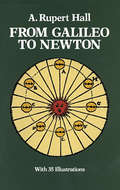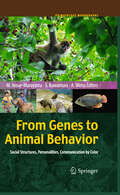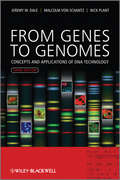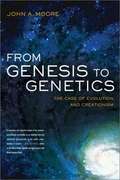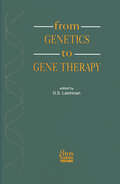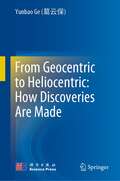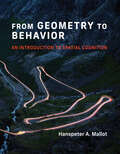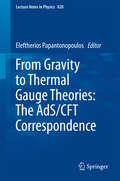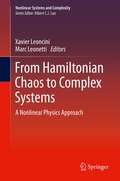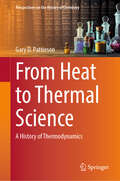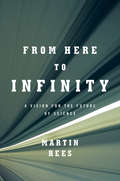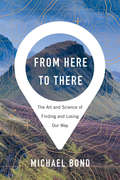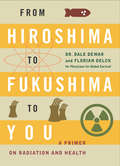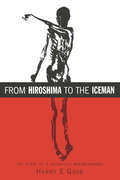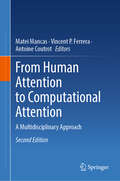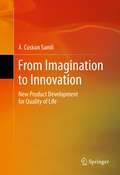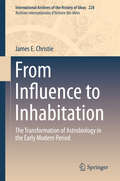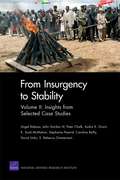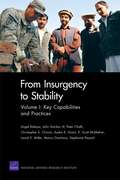- Table View
- List View
From Flood Safety to Spatial Management: Expert-Policy Interactions in Dutch and US Flood Governance (Water Governance - Concepts, Methods, and Practice)
by Emmy BergsmaThis book deals with the introduction of a new type of “spatial measures" in flood governance. In contrast to traditional “safety measures" that aim to provide protection against floods by building structural flood defenses such as levees and flood walls, the goal of spatial measures is to reduce the exposure to flood risks by changing the spatial layout of flood-prone areas. By limiting developments and flood-proofing buildings in areas at risk to flooding, investments in structural flood defenses can be circumvented and vulnerabilities reduce. World-wide, spatial measures are gaining attractiveness as a response strategy to increasing flood risks caused by climate change and urbanization. The introduction of spatial measures in flood governance involves more than the simple development of new policies and laws. Research has demonstrated that the implementation of spatial measures can have huge implications for how costs and responsibilities are divided between different levels of governance and between public and private actors, changing the whole organization behind flood governance. Both for the effectiveness and for the legitimacy of spatial flood governance strategies, it is important that these distributive implications are well understood. This book describes the introduction of spatial measures in the context of two very different delta countries: the Netherlands and the United States. In the United States, a spatial flood governance strategy was already developed in de mid-20th century whereas in the Netherlands, a safety paradigm institutionalized over the course of the 20th century and spatial measures have only recently been introduced. By analyzing the science-policy interactions underlying the implementation of spatial measures in both countries, this book shows how under the influence of different types of experts (engineers in the Netherlands and social geographers in the United States) different spatial flood management strategies emerged with different distributive implications, each with its own challenges for effectiveness and legitimacy.
From Fossil Fuels to Low Carbon Energy Transition: New Regulatory Trends in Latin America (Energy, Climate and the Environment)
by Geoffrey Wood Juan Felipe Neira-CastroFocusing on five key themes - hydrocarbons, electricity, mining, social license to operate, and arbitration/dispute resolution- via in-depth country and regional case studies, this book seeks to capture the contrasting and sometimes conflicting trends in energy governance in Latin America as it wrestles with a dependence on fossil fuels whilst shifting toward a low carbon future. Energy transition continues to sit at the centre of the Latin American policy debate as the world continues to push for carbon neutrality by 2050. Latin America is undergoing a renewable energy transition, with substantial reserves (solar, wind, hydro, geothermal) and many countries in the region setting ambitious renewable energy policies, laws, and regulations to address climate change. However, recent initiatives to promote renewables must be placed in context. Historically, Latin America has developed and improved its economic and social standards due primarily to an economy based on the extractive industries and fossil fuels. This places renewables at the crossroads of multiple drivers, as the region seek to ensure security of supply, attract investment, and facilitate a low carbon energy transition.
From Galileo to Newton
by A. Rupert HallThe near century (1630-1720) that separates the important astronomical findings of Galileo Galilei (1564-1642) and the vastly influential mathematical work of Sir Isaac Newton (1642-1727) represents a pivotal stage of transition in the history of science. As a result of the raging intellectual battle between tradition and innovation that began in the fifteenth century, science was penetrated by a new outlook that placed emphasis on experiment and observation. Galileo showed the promise of its new methods of discovery; Newton brought out their full force and effect. Galileo suffered from an attempt to censure scientific inquiry; Newton showed how science could discover the universal laws of nature. The triumph of this new outlook marked the birth of modern science.From Galileo to Newton describes those new patterns of thought that emerged during this time of great excitement and widespread controversy. It discusses the discoveries revealed by telescope and microscope in the work of Huygens and Leeuwenhoek, and the new speculations to which these gave rise; Boyle's attempts to include chemical experiments within a rational theory of matter, and those begun by Descartes to explain the workings of the body on the basis of chemical and physical principles; and the revolutionary ideas in astronomy that generated the transition from the Ptolemaic concept of the universe to the Copernican and the subsequent acceptance of the heliostatic system.Since the dawn of civilization man has tried to find logic in the mysterious and order in the chaotic. From Galileo to Newton will appeal to anyone who wants to know what modern science is all about and how it came into being. One of the foremost authorities on the history of science, Professor Hall is not only a scholar of great learning and originality, he also writes with clarity, liveliness, and a keen biographical sense.
From Genes to Animal Behavior
by Alexander Weiss Shoji Kawamura Miho Inoue-MurayamaThe biological and genetic bases of behavioral diversity have long been topics of study within many disciplines, including evolutionary biology, genetics, ethology, sociobiology, and comparative psychology, but only relatively recently have attempts been made to bring these different approaches together. This volume covers a wide range of interdisciplinary research which uses some of the newest and most promising methods and technologies. Presented here is an overview of findings in the ongoing search for the ultimate causes of behavior in several different species, including primates, dogs, rodents, birds, and fish. Divided into five parts, the work describes research on sexual and kin selection, personality and temperament, molecular genetics of personality, color vision and body coloration, and the neurological underpinnings of complex behaviors. Valuable for researchers as well as graduate students in a wide range of fields from neuroscience to ecology, the book is also useful to those seeking to move beyond the boundaries of their own discipline and to expand their knowledge.
From Genes to Genomes
by Jeremy W. Dale Malcolm Von Schantz Nicholas PlantThe latest edition of this highly successful textbook introduces the key techniques and concepts involved in cloning genes and in studying their expression and variation.The new edition features:Increased coverage of whole-genome sequencing technologies and enhanced treatment of bioinformatics.Clear, two-colour diagrams throughout.A dedicated website including all figures.Noted for its outstanding balance between clarity of coverage and level of detail, this book provides an excellent introduction to the fast moving world of molecular genetics.
From Genesis to Genetics: The Case of Evolution and Creationism
by John A. MooreA distinguished science educator's clear and fair-minded accounts of evolution and creationism: two irreconcilable modes of seeing the world, science and religion.
From Genetics to Gene Therapy: The Molecular Pathology of Human Disease
by David S. LatchmanDistinguished scientists provide an overview of the molecular pathology of human disease. Each chapter provides an analysis of the molecular biological approaches to individual diseases, such as leukaemia, cardiovascular disease and cancer. To celebrate the formation of the new Department a I-day meeting entitled 'From Genetics to Gene Therapy' was held on 14 December 1992, at which a large audience was inspired by talks from a variety of distinguished speakers. This volume is based on the meeting and contains contributions provided by the invited speakers.
From Geocentric to Heliocentric: How Discoveries Are Made
by Yunbao Ge (葛云保)Has anyone ever seen with their own eyes that the Earth goes around the sun? Even to this day, no one has. However, 500 and even 2000 years ago, some astronomers managed to point out that this is the case. At that time, people’s range of activities was strictly confined, the technology and tools used were extremely primitive, and many of the mathematical methods used today had not been developed. How did those astronomers make and verify this discovery? This book explains this exciting demonstration process. It enables anyone with a basic junior-high-school knowledge of geometry and a certain degree of spatial imagination to understand this and other interesting discoveries in the solar system. By demonstrating this interesting process, the book not only satisfies readers' curiosity using the simplest mathematics, but also inspires them to explore the new and unknown world.
From Geometry to Behavior: An Introduction to Spatial Cognition
by Hanspeter A. MallotAn overview of the mechanisms and evolution of spatial cognition, integrating evidence from psychology, neuroscience, cognitive science, and computational geometry.Understanding how we deal with space requires input from many fields, including ethology, neuroscience, psychology, cognitive science, linguistics, geography, and spatial information theory. In From Geometry to Behavior, cognitive neuroscientist Hanspeter A. Mallot provides an overview of the basic mechanisms of spatial behavior in animals and humans, showing how they combine to support higher-level performance. Mallot explores the biological mechanisms of dealing with space, from the perception of visual space to the constructions of large space representations: that is, the cognitive map. The volume is also relevant to the epistemology of spatial knowledge in the philosophy of mind.Mallot aims to establish spatial cognition as a scientific field in its own right. His general approach is psychophysical, in that it focuses on quantitative descriptions of behavioral performance and their real-world determinants, thus connecting to the work of theorists in computational neuroscience, robotics, and computational geometry. After an overview of scientific thinking about space, Mallot covers spatial behavior and its underlying mechanisms in the order of increasing memory involvement. He describes the cognitive processes that underlie advanced spatial behaviors such as directed search, wayfinding, spatial planning, spatial reasoning, object building and manipulation, and communication about space. These mechanisms are part of the larger cognitive apparatus that also serves visual and object cognition; understanding events, actions, and causality; and social cognition, which includes language. Of all of these cognitive domains, spatial cognition most likely occurred first in the course of evolution and is the most widespread throughout the animal kingdom.
From Gravity to Thermal Gauge Theories: The AdS/CFT Correspondence
by Eleftherios PapantonopoulosThe AdS/CFT correspondence is a powerful tool in studying strongly coupled phenomena in gauge field theories, using results from a weakly coupled gravity background studied in the realm of string theory. AdS/CFT was first successfully applied to the study of phenomena such as the quark-gluon plasma produced in heavy ions collisions. Soon it was realized that its applicability can be extended, in a more phenomenological approach, to condensed matter systems and to systems described by fluid dynamics. The set of tutorial reviews in this volume is intended as an introduction to and survey of the principle of the AdS/CFT correspondence in its field/string theoretic formulation, its applicability to holographic QCD and to heavy ions collisions, and to give a first account of processes in fluid dynamics and condensed matter physics, which can be studied with the use of this principle. Written by leading researchers in the field and cast into the form of a high-level but approachable multi-author textbook, this volume will be of benefit to all postgraduate students, and newcomers from neighboring disciplines wishing to find a comprehensive guide for their future research.
From Hamiltonian Chaos to Complex Systems: A Nonlinear Physics Approach
by Xavier Leoncini Marc LeonettiFrom Hamiltonian Chaos to Complex Systems: A Nonlinear Physics Approach collects contributions on recent developments in non-linear dynamics and statistical physics with an emphasis on complex systems. This book provides a wide range of state-of-the-art research in these fields. The unifying aspect of this book is demonstration of how similar tools coming from dynamical systems, nonlinear physics, and statistical dynamics can lead to a large panorama of research in various fields of physics and beyond, most notably with the perspective of application in complex systems.
From Hand to Mouth: The Origins of Language
by Michael C. CorballisIt is often said that speech is what distinguishes us from other animals. But are we all talk? What if language was bequeathed to us not by word of mouth, but as a hand-me-down? The notion that language evolved not from animal cries but from manual and facial gestures--that, for most of human history, actions have spoken louder than words--has been around since Condillac. But never before has anyone developed a full-fledged theory of how, why, and with what effects language evolved from a gestural system to the spoken word. Marshaling far-flung evidence from anthropology, animal behavior, neurology, molecular biology, anatomy, linguistics, and evolutionary psychology, Michael Corballis makes the case that language developed, with the emergence of Homo sapiens, from primate gestures to a true signed language, complete with grammar and syntax and at best punctuated with grunts and other vocalizations. While vocal utterance played an increasingly important complementary role, autonomous speech did not appear until about 50,000 years ago--much later than generally believed. Bringing in significant new evidence to bolster what has been a minority view, Corballis goes beyond earlier supporters of a gestural theory by suggesting why speech eventually (but not completely!) supplanted gesture. He then uses this milestone to account for the artistic explosion and demographic triumph of the particular group of Homo sapiens from whom we are descended. And he asserts that speech, like written language, was a cultural invention and not a biological fait accompli. Writing with wit and eloquence, Corballis makes nimble reference to literature, mythology, natural history, sports, and contemporary politics as he explains in fascinating detail what we now know about such varied subjects as early hominid evolution, modern signed languages, and the causes of left-handedness. From Hand to Mouth will have scholars and laymen alike talking--and sometimes gesturing--for years to come.
From Headwaters to the Ocean: Hydrological Change and Water Management - Hydrochange 2008, 1-3 October 2008, Kyoto, Japan
by Makoto Taniguchi Martin Haigh William C. Burnett Yoshihiro Fukushima Yu UmezawaThe vulnerability of water resources due to climate change and human activities is globally increasing. The phenomenon of hydrological change is complicated because of the combinations and interactions between natural climate fluctuation, global warming and human activities including changes in land utilization. The impact areas of hydrological cha
From Heat to Thermal Science: A History of Thermodynamics (Perspectives on the History of Chemistry)
by Gary D. PattersonThis book explores the human understanding of heat, from early cultural perceptions to the scientific developments that shaped thermal science. Beginning with historical musings on heat, it traces the evolution of scientific thought from 16th-century Italy to the quantum understanding of heat in the 20th century. The book examines how humans have perceived, measured, and produced heat, leading to a unified concept that has remained constant: "heat flows from a hot body to a cold body''. It serves as an excellent resource for chemists and anyone interested in the history of chemistry and science.
From Here to Infinity: A Vision for the Future of Science
by Martin ReesOne of our greatest scientific minds reflect on the role of science in the twenty-first century. Science is often portrayed as an obscure, difficult discipline, governed by elite researchers and inaccessible to the general public. In this riveting, inspiring new book, preeminent astrophysicist Martin Rees overturns this view, urging improved communication between researchers and laypeople. In order to shape debates over healthcare, energy policy,space travel, and other vital issues, ordinary citizens must develop a "feel" for science--the one truly global culture--and engage directly with research rather than relying on pundits' and politicians' interpretations. Recognized as an expert on the political and ethical impact of science, Rees demonstrate show we must solve the new challenges we face--from population growth to climate change--by devising strategies with a long-term, global perspective. In the process, he offers insights into the prospects for future discoveries while also explaining science's intrinsic limits. Just as importantly, Rees reminds us that science should be a source of pleasure and wonder for specialists and nonspecialists alike.
From Here to There: Inventions That Changed the Way the World Moves
by Gilbert Ford Vivian KirkfieldCelebrating the invention of vehicles, this collective biography tells the inspiring stories of the visionaries who changed the way we move across air, water, and land. Perfect for fans of Mistakes that Worked and Girls Think of Everything.In a time when people believed flying was impossible, Joseph and Etienne Montgolfier proved that the sky wasn&’t the limit. When most thought horseback was the only way to race, Bertha and Karl Benz fired up their engines. From the invention of the bicycle and the passenger steam locomotive, to the first liquid-fuel propelled rocket and industrial robot, inventors across the world have redefined travel. Filled with informative sidebars and colorful illustrations, this collective biography tells the story of the experiments, failures, and successes of visionaries who changed the way the world moves.
From Here to There: The Art and Science of Finding and Losing Our Way
by Michael BondA wise and insightful exploration of human navigation, what it means to be lost, and how we find our way. How is it that we can walk unfamiliar streets while maintaining a sense of direction? Come up with shortcuts on the fly, in places we’ve never traveled? The answer is the complex mental map in our brains. This feature of our cognition is easily taken for granted, but it’s also critical to our species’ evolutionary success. In From Here to There Michael Bond tells stories of the lost and found—Polynesian sailors, orienteering champions, early aviators—and surveys the science of human navigation. Navigation skills are deeply embedded in our biology. The ability to find our way over large distances in prehistoric times gave Homo sapiens an advantage, allowing us to explore the farthest regions of the planet. Wayfinding also shaped vital cognitive functions outside the realm of navigation, including abstract thinking, imagination, and memory. Bond brings a reporter’s curiosity and nose for narrative to the latest research from psychologists, neuroscientists, animal behaviorists, and anthropologists. He also turns to the people who design and expertly maneuver the world we navigate: search-and-rescue volunteers, cartographers, ordnance mappers, urban planners, and more. The result is a global expedition that furthers our understanding of human orienting in the natural and built environments. A beguiling mix of storytelling and science, From Here to There covers the full spectrum of human navigation and spatial understanding. In an age of GPS and Google Maps, Bond urges us to exercise our evolved navigation skills and reap the surprising cognitive rewards.
From Hiroshima to Fukushima to You: A Primer on Radiation and Health
by Florian Oelck Dale DewarThe bombing of Hiroshima on August 6, 1945, brought radiation to international attention but the exact nature of what had been unleashed was still unclear to most. The 1986 meltdown at the Chernobyl nuclear plant again made headlines with estimates of fatalities ranging from 4000 to almost a million deaths. By the time of the shocking 2011 disaster at the Fukushima nuclear plant social media meant governments and corporations no longer had a monopoly over the release of information, but transparency remains low on the agenda. Meanwhile, few physicians give thought to the delayed health effects of radiation. It has been the bold physician who has challenged the potential overuse of chest X-rays, CT scanning, or PET scans. This book provides clear and accurate information about radiation so that we can all make informed choices. In clear language it offers answers to citizens’ questions: What is radiation? Where do we encounter it? What are the benefits and risks? How do we develop a responsible future around the uses and abuses of radioactivity?
From Hiroshima to the Iceman: The Development and Applications of Accelerator Mass Spectrometry
by Harry E GoveFrom Hiroshima to the Iceman: The Development and Applications of Accelerator Mass Spectrometry presents a fascinating account of a breakthrough in science and the insights it has brought that would not have been possible without it. Involved since its invention, Harry Gove recounts the story of the development of accelerator mass spectrometry and its use as an ultrasensitive detection technique in many fields of science and the arts. A key advantage of the technique is that it requires only very small samples of material. The book explores the areas where the technique has increased understanding and provided solutions to problems, including the clean-up and storage of nuclear waste, the effects of the atomic bombing of Hiroshima, biomedical research, the settling of the Americas, and carbon dating of many precious artifacts. Objects dated include the Turin Shroud, the Iceman, the elephant bird egg, and the Dead Sea scrolls.
From Human Attention to Computational Attention: A Multidisciplinary Approach
by Matei Mancas Vincent P. Ferrera Antoine CoutrotThe new edition of this popular book introduces the study of attention, focusing on attention modeling, and addressing such themes as saliency models, signal detection, and different types of signals, including real-life applications. The first edition was written at a moment when the Deep Learning Neural Network (DNNs) techniques were just at their beginnings in terms of attention. Deep learning has recently become a key factor in attention prediction on images and video, and attention mechanisms have become key factors in deep learning models. The second edition tackles the arrival of DNNs for attention computing in images and video, and also discusses the attention mechanisms within DNNs (attention modules, transformers, grad-cam-based saliency maps, etc.). From Human Attention to Computational Attention 2nd Edition also explores the parallels between the brain structures and the DNN architectures to reveal how biomimetics can improve the model designs. The book is truly multi-disciplinary, collating work from psychology, neuroscience, engineering, and computer science.
From Hysteria to Hormones: A Rhetorical History (RSA Series in Transdisciplinary Rhetoric #7)
by Amy KoerberIn From Hysteria to Hormones, Amy Koerber examines the rhetorical activity that preceded the early twentieth-century emergence of the word hormone and the impact of this word on expert understandings of women’s health.Shortly after Ernest Henry Starling coined the term “hormone” in 1905, hormones began to provide a chemical explanation for bodily phenomena that were previously understood in terms of “wandering wombs,” humors, energies, and balance. In this study, Koerber posits that the discovery of hormones was not so much a revolution as an exigency that required old ways of thinking to be twisted, reshaped, and transformed to fit more scientific turn-of-the-century expectations of medical practices. She engages with texts from a wide array of medical and social scientific subdisciplines; with material from medical archives, including patient charts, handwritten notes, and photographs from the Salpêtrière Hospital, where Dr. Jean Charcot treated hundreds of hysteria patients in the late nineteenth century; and with current rhetorical theoretical approaches to the study of health and medicine. In doing so, Koerber shows that the boundary between older, nonscientific ways of understanding women’s bodies and newer, scientific understandings is much murkier than we might expect.A clarifying examination of how the term “hormones” preserves key concepts that have framed our understanding of women’s bodies from ancient times to the present, this innovative book illuminates the ways in which the words we use today to discuss female reproductive health aren’t nearly as scientifically accurate or socially progressive as believed. Scholars of rhetoric, gender studies, and women’s health will find Koerber’s work provocative and valuable.
From Imagination to Innovation
by A. Coskun SamliIt is impossible to measure the full economic and psychological benefits of the sewing machine, the polio vaccine, or the Internet. What we know is that these products have changed our lives for the better, generating net benefits well beyond the metric of corporate profits. As forces such as financial market volatility and fragmented markets demonstrate the fragility of the global economy, the imperative to develop products and services that contribute to the well-being of the many--rather than the few--is more pronounced than ever. In this book, A. Coskun Samli explores this imperative of an "innovation culture" and how it can be encouraged at all levels, from the individual to the nation or region. He argues that without a global innovation culture, committed to generating socially valuable products, we are likely to face a deteriorating quality of life, as wealth is concentrated at the top. Integrating insights from management, economics, policy, and psychology, Samli demonstrates how creativity can be channeled into innovation and innovation can be channeled, in turn, toward economic development. He discusses how national policies can be oriented toward encouraging such socially beneficial innovations as sustainable energy, communication technology, and medical discoveries. The aim is to promote the development of products and services that improve quality of life and generate profits for those who invest in them. He argues that all innovations, whether radical or incremental, must demonstrate social value in order to be truly profitable.
From Influence to Inhabitation: The Transformation of Astrobiology in the Early Modern Period (International Archives of the History of Ideas Archives internationales d'histoire des idées #228)
by James E. ChristieThis book describes how and why the early modern period witnessed the marginalisation of astrology in Western natural philosophy, and the re-adoption of the cosmological view of the existence of a plurality of worlds in the universe, allowing the possibility of extraterrestrial life. Founded in the mid-1990s, the discipline of astrobiology combines the search for extraterrestrial life with the study of terrestrial biology – especially its origins, its evolution and its presence in extreme environments. This book offers a history of astrobiology's attempts to understand the nature of life in a larger cosmological context. Specifically, it describes the shift of early modern cosmology from a paradigm of celestial influence to one of celestial inhabitation. Although these trends are regarded as consequences of Copernican cosmology, and hallmarks of a modern world view, they are usually addressed separately in the historical literature. Unlike others, this book takes a broad approach that examines the relationship of the two. From Influence to Inhabitation will benefit both historians of astrology and historians of the extraterrestrial life debate, an audience which includes researchers and advanced students studying the history and philosophy of astrobiology. It will also appeal to historians of natural philosophy, science, astronomy and theology in the early modern period.
From Insurgency to Stability: Insights from Selected Case Studies
by Peter Chalk Angel Rabasa John Gordon Audra K. Grant K. Scott McmahonThis book examines six case studies of insurgencies from around the world to determine the key factors necessary for a successful transition from counterinsurgency to a more stable situation. The authors review the causes of each insurgency and the key players involved, and examine what the government did right--or wrong--to bring the insurgency to an end and to transition to greater stability.
From Insurgency to Stability: Key Capabilities and Practices
by Peter Chalk Angel Rabasa Christopher S. Chivvis John Gordon Audra K. GrantThis book identifies the procedures and capabilities that the U.S. Department of Defense, other agencies of the U.S. government, U.S. allies and partners, and international organizations require in order to support the transition from counterinsurgency, when the military takes primary responsibility for security and economic operations, to stability and reconstruction, when police and civilian government agencies take the lead.


